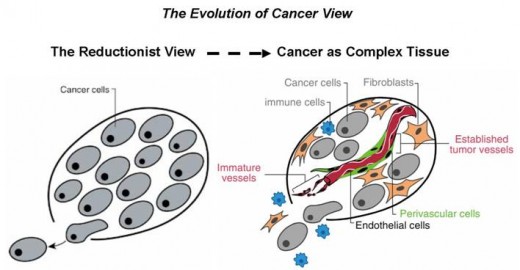What is Cancer - A Failure of Cell Death (Part 1 of 3)
What do Tumours Look Like?

Some Background...
- What Are Cells Made Of? - Eukaryotic Animal Cell Structure (Part 1 of 3)
A Tour of the Eukaryotic Animal Cell. Provides a brief outline of the functions of the organelles in a Eukaryotic Cell, as well as giving some helpful analogies to aid memory. Don't forget to check out parts 2 and 3 of this series - linked below!
What is Cancer?
My previous hubs have centered on the structure of various cell types. We have explored their organelles, functions, similarities and differences. It is now time to put some of this knowledge to good use in this series: Understanding Cancer
The subject of my final year thesis, cancer is a fascinating field. As is often the case in biology, more has been discovered about the function and operation of specific genes, proteins and cells when said activities malfunction. One of the most emotive and dangerous of these malfunctions is Cancer.
In this series we will look at some of the opposing biological functions that fight for dominance in our body. We shall see how a single protein malfunctioning can bring about disaster and why a developing tumour is analogous to Darwinian evolution. The final part of the series investigates the various strategies for combating this most insidious of foes, and looks carefully at side-effects.
Most importantly and throughout this series, it is vital to keep in mind the paradox, first proffered by Bowen, Bowen and Jones in 1998:
"...the whole of metazoan life is dependent on death…the life of every cancer patient can potentially be saved by enhancing cell death."
Tumorigensis and Metastasis
Key Stages in Cancer Development
The above video shows, succinctly, two of the most important and dangerous steps in cancer progression. (NB: there are over 200 cells types in your body, each being susceptible to developing into a cancer. As such, the number of cancer types stands at over 200, not 100 as stated in the video)
Early in the video, you can clearly see the growing mass of cells directly affecting their surroundings. Not only do they cause other cells to become cancerous, but they induce blood vessel formation to feed their growing colony. This process, known as angiogenesis, is key for tumours to become malignant - by inhibiting angiogenesis, we can starve these tumour cells, killing them off.
Later on we see the most lethal characteristic of developing cancers - metastasis. A tumour contained in a small, or at least defined, area is a tumour that can be readily removed. A tumour that manages to escape these confines and spread to new pastures is a deadly and evasive foe. It should be noted, that metastases are often the cause of human cancer deaths.
The rest of this series will investigate key concepts, processes or developments in cancer biology. With this disease affecting (directly or indirectly) around 1 in 3, an understanding about this disease is vital for all
Where Next? Cancer
- Cancer - NHS Choices
Find everything you need to know about Cancer including causes, symptoms, diagnosis and treatment, with links to other useful resources. - What cancer is : Cancer Research UK : CancerHelp UK
A basic, patient-centered page describing what cancer is, with links to statistics and cancer types. Good for a general overview, but does lack detail in areas - Illustrated Information
Research discoveries can have unexpected benefits, epitomised in the work of Sydney Brenner, H. Robert Horvitz, John E. Sulston, who won the Nobel Prize in Physiology in 2002. Their work has opened new avenues in the fight against cancer.







